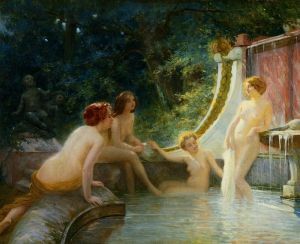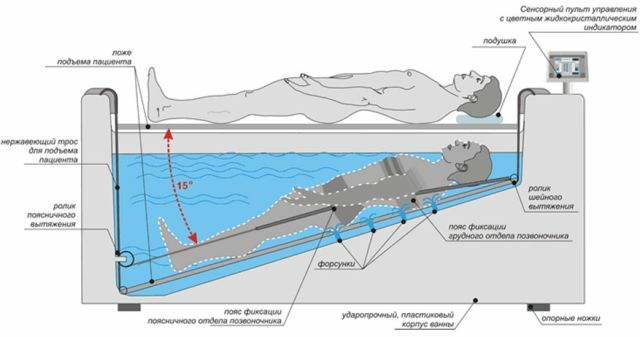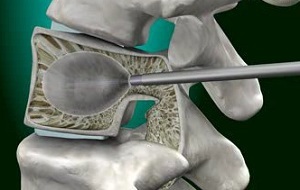 Balneotherapy is one of the oldest methods of treatment, which boils down to bathing in natural springs of mineral waters or in artificial pools.
Balneotherapy is one of the oldest methods of treatment, which boils down to bathing in natural springs of mineral waters or in artificial pools.
Since this field of medicine has demonstrated excellent results for many years and has been actively developing, balneotherapy also includes such kinds of balneotherapy procedures as intestinal washing with mineral waters, aromatic baths, irrigation, special inhalations and much more.
A huge advantage of this method of treatment is the almost complete absence of side effects and the possibility of harming one's own organism, so it clearly deserves attention.
From the history of the formation of
The term balneotherapy itself is derived from the Latin words balneum and therapia, which literally means "healing baths", but its age is much older than the Roman Empire, because the prophet Moses himself recommended all Jews regularly hold special ablutions in order to protectyourself from a multitude of ailments.
Residents of Ancient Egypt were also well aware of the curative effects of mineral waters on the human body and often practiced similar treatments. From there the technique fell into Greece, where Hippocrates himself took it into service and significantly supplemented it.
Until now, the famous Greek baths have been preserved, in which people stay for a long time in tanks with heated water, saturated with minerals and salts.
A hundred years ago, the treatment at the resorts involved bathing in mineral springs. To date, the

Therapeutic Bathing has been practiced in the Roman Empire by
, as well as many written works of healers of those years.
For example, the books of Sebastian Kneipp, who described numerous methods of water treatment, were reprinted more than forty times and were translated into most languages.
At the very beginning of the nineteenth century the first hydropathic clinic was inaugurated in Moscow, and a little later a similar institution appeared in St. Petersburg.
In addition to special baths, they were equipped with storage for drinking mineral water, in which there were several dozen varieties that were taken depending on the disease.
Who will benefit from swimming?
Balneotherapy shows excellent results in the treatment of diseases of the joints and muscle tissue. Mineral baths establish a metabolism in the tissues surrounding the joints, improving local blood circulation and reducing the activity of inflammatory processes.
This treatment is effective for arthritis and gout, helping to improve the patient's condition and reduce pain.
In addition, the presence in mineral baths stimulates the production of hormones of the corticosteroid series, which have a powerful anti-inflammatory effect, while strengthening the joints and bone apparatus.
Balneotherapy is also indicated for the following problems:
- of digestive system diseases;
- diseases of respiratory organs, eyes, urinary tract and kidney;
- diseases of the nervous system, endocrine disorders and disorders associated with improper metabolism;
- problems with circulatory system, with skin and subcutaneous tissue;
- gynecological diseases.
Unfortunately, not all
Contraindications to balneotherapy, too, is:
- tuberculosis, which occurs in the acute phase;
- atherosclerosis and propensity to failures in coronary and cerebral circulation;
- weak or insufficient blood circulation;
- angina in severe form and thrombophlebitis with relapses;
- predisposition to bleeding;
- diabetes in severe form;
- presence of fungal skin lesions and dandruff;
- inflammatory processes occurring in the acute stage;
- aneurysm of blood vessels or heart;
- varicose enlargement, which is accompanied by a trophic disorder;
Balneotherapy is also contraindicated in the second half of pregnancy and people who have recently suffered a stroke or myocardial infarction.
People with chronic liver diseases, stomach ulcers and bronchial asthma are contraindicated with a sulphide type balneotherapy.
Radon baths are contraindicated in hypoestrogenia, hypothyroidism, radiation sickness and pregnancy.
Iodide-bromide waters are not recommended for hives, haemorrhagic dermatitis and intolerance to iodine.
Chloride baths are contraindicated in autonomic polyneuropathy and inflammatory diseases in the acute stage.
Balneotherapy methods

Hydrogen bath
The most common type of balneotherapy is individual and shared baths. They contribute to the strengthening of the nervous, cardiovascular and digestive systems, and also have a beneficial effect on the metabolism, musculoskeletal system, on the condition of the skin and kidneys.
There are also local baths that are filled with radon, sulphide and other waters and are usually used as a supplement to traditional baths. Most often, they are prescribed for diseases of bones and muscle tissues and disorders in the work of the peripheral nervous system.
In balneotherapy, the method of contrast baths is used, in which the patient is exposed to mineral water of different temperatures, which is especially effective for skin diseases and varicose veins.
A shower with radon and sulphide mineral water happens to be local, at which irrigation of the face and head occurs, this kind of procedure is used for neuroses and problems with the hair. Also used is an ascending( or crotch) shower, which has a beneficial effect in diseases of the genitals.
When obesity and various ailments associated with the musculoskeletal system, often use a massage in the form of an underwater shower, which combines thermal and mechanical effects with radon and sulphide water. Some patients are recommended to take a massage shower with sulphide-type water.
In pools filled with various mineral waters, they often hold gymnastics for people with diseases of muscles and bones and with impaired mobility of the joints. Performing a similar gymnastics in the air is difficult, so a pool with mineral or sea water is the best solution for them.
Features of various types of procedure
Chloride-sodium baths are irritating to the skin, and the salt remains for some time and after the end of the procedure, strengthening the therapeutic effect. 
Also, due to stimulation of the adrenal glands, blood circulation comes back to normal and the work of the central nervous system improves. Baths with bromine and iodine lower blood pressure, promote normalization of muscle tone, improve the condition of the tendon and thyroid gland.
Sulfide baths improve heart function and stabilize blood pressure. Baths with radon relieve inflammation and reduce pain syndrome. Carbonic baths exert a stimulating effect on the nervous system and are effective even for depressive disorders.
Different baths can have both sedative and stimulating effects. Properly choosing the course with the most suitable water, you can significantly improve your own immunity, remove toxins and toxins from the body, activate the endocrine, nervous and cardiovascular systems, and reduce inflammation in the joints and muscle tissues.



